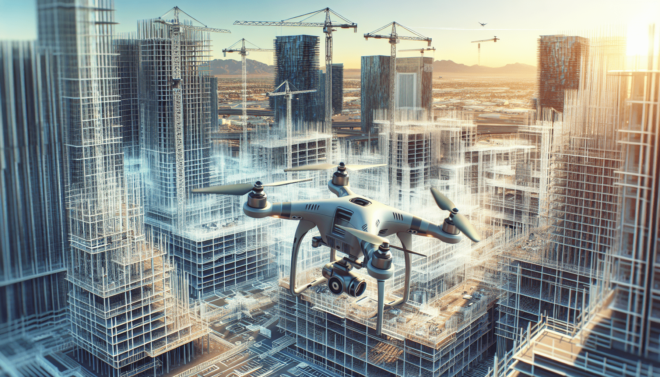Have you ever thought about why flying drones near certain construction zones, especially in a place like Las Vegas, is considered illegal? It’s an intriguing subject that straddles the line between public safety and the allure of cutting-edge technology. With drones becoming increasingly popular for photography, videography, and even surveying, it’s essential to understand the rules and regulations around their use. Before you send your drone soaring through the Nevada skies, understanding these boundaries could save you from hefty fines or legal trouble.
Understanding Drone Regulations
What Are Drones and Why Are They Popular?
Drones, or unmanned aerial vehicles (UAVs), have captured the imagination of hobbyists and professionals alike. They offer unique perspectives of landscapes, landmarks, and events, making them popular for recreational and professional use. With technological advancements, drones have become more accessible and user-friendly, further fueling their popularity.
Federal Aviation Administration (FAA) Guidelines
The Federal Aviation Administration (FAA) governs the use of drones in the United States. They ensure the safety of airspace, both for manned and unmanned aircraft. The rules are extensive, but key points include keeping your drone within your line of sight and prohibiting flying above certain altitudes or near airport zones. Failing to adhere to these regulations could pose dangers, not only to air traffic but also to people and property on the ground.
Local Regulations and Exceptions
While FAA regulations provide a federal framework, local governments have the authority to impose additional restrictions. In places like Las Vegas, local drone laws exist to provide extra safeguards. Construction zones are among the areas strictly regulated due to their unique risks and complexities.
The Risks of Flying Drones Near Construction Zones
Safety Concerns
Construction zones are inherently hazardous environments. They involve heavy machinery, scaffolding, and ongoing construction work. Flying drones in these areas could lead to accidents, either by crashing into machinery or causing distractions that lead to worker injuries.
Privacy Infringements
Privacy is another significant concern. Construction sites often deal with sensitive projects, and unauthorized drone flights could result in the unwanted capture of proprietary designs or confidential details. Ensuring privacy is one reason why regulations are strictly enforced around certain zones, especially those involving significant developments or infrastructure.
Security Threats
Drones can also pose security threats. Construction projects, especially high-profile ones, might involve sensitive political or commercial details. Unauthorized drones flying nearby could inadvertently—or purposefully—compromise project confidentiality or security.
Specific Case: Las Vegas
Why Las Vegas?
Las Vegas is a city of innovation and extravagance, continually evolving with new construction projects designed to amaze. This constant development makes it a hotspot for drone restrictions to ensure safety and confidentiality.
Major Projects and Their Implications
Significant projects in Las Vegas, such as new casinos or infrastructure improvements, often require heightened security. Protection of intellectual property and prevention of external disruptions are crucial, explaining the stringent drone regulations. Whether it’s a new hotel on the Strip or improvements to public transport, the stakes are high, and the risks involve both safety and commercial interests.
Legal Implications
What Happens If You Break the Law?
Infringing drone regulations around construction zones can lead to serious legal consequences. Possible repercussions include fines, legal fees, and confiscation of your drone. The severity of penalties often depends on the risk posed by your actions or whether the incident resulted in an accident or security breach.
| Violation Type | Potential Consequences |
|---|---|
| Flying without Required License | Fines, Confiscation of Drone |
| Breach of Safety (causing injury) | Criminal Charges, Civil lawsuits |
| Privacy Infringement | Fines, Potential Lawsuits |
| Security Violation | Severe Fines, Legal Action, Imprisonment |
Understanding these potential outcomes is critical to responsibly enjoying drone technology.
How to Legally Fly a Drone Near Construction Zones?
Before planning a flight, ensure you are familiar with both federal and local regulations. Obtaining any necessary permits or permissions is vital to avoid legal issues. Often, contacting local authorities for guidance will provide the clarity you need to fly your drone safely and legally.
Technological Solutions
Advances in Drone Technology
As technology improves, so do drone capabilities. Innovations like geofencing help prevent drones from entering restricted areas automatically. With built-in GPS and mapping systems, modern drones can alert users when they approach no-fly zones, making accidental breaches less likely.
Software and Apps
Many apps now provide updated maps of no-fly zones, including real-time updates about temporary restrictions due to construction or events. These tools are invaluable for drone enthusiasts, offering a simple way to stay within legal boundaries.
The Future of Drones in Construction Zones
Evolving Regulations
As drone technology advances, so do the regulations. Future developments will likely balance technological possibilities with safety and security needs. Keeping informed about these changes is crucial for drone operators who wish to stay compliant.
Potential Benefits
Despite the risks, drones offer incredible benefits to the construction industry. They provide unique viewpoints for planning, surveying, and inspection, contributing to improved efficiency and accuracy. When used appropriately and legally, drones can greatly enhance construction projects, providing data that would otherwise be costly and time-consuming to obtain.
Conclusion: Drone Responsibility
Drones provide endless possibilities, offering aerial views that were once inaccessible to amateurs and professionals alike. However, with this freedom comes responsibility. Understanding why certain areas, like construction zones in Las Vegas, have flight restrictions can help you appreciate the delicate balance between exploring technology and ensuring safety. By adhering to regulations and staying informed, you can enjoy the benefits of drone technology while maintaining respect for the law and those around you.

